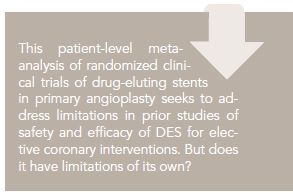Publication
Article
Cardiology Review® Online
Drug-Eluting Versus Bare-Metal Stents in Primary Angioplasty

Mehdi H. Shishehbor, DO , MPH
Review
De Luca G; Dirksen MT, Spaulding C, et al. Drug-eluting vs bare-metal stents in primary
angioplasty: a pooled patient-level meta-analysis of randomized trials. Arch Intern Med.
2012;172:611-621

In patients undergoing elective percutaneous coronary intervention (PCI), drug-eluting stents (DES), compared with bare metal stents (BMS), have consistently been shown to reduce the risk of target vessel revascularization (TVR) without a significant risk of myocardial infarction or death.1 This benefit is even more pronounced among the third-generation DES.2,3 While stent thrombosis (ST) continues to be a concern with DES, recent large-scale studies suggest even lower ST with some thirdgeneration DES compared with BMS in elective PCI.2 Despite the reassuring data regarding safety and efficacy of DES for elective coronary interventions, concerns remain about ST in higher-risk patients, such as those presenting with non-ST elevation myocardial infarction (NSTEMI) or ST-elevation myocardial infarction (STEMI).4 The risk of stent thrombosis per year is about 4.4% for STEMI patients, compared with NSTEMI (~1.5%) or elective PCI (0.1-0.6%).4
A number of mechanisms may explain why individuals with STEMI experience higher rates of ST, including noncompliance, technical errors such as undersizing, and issues related to plaque morphology, inflammation, and lateacquired stent malapposition (LASM).5 Because of this concern, many randomized clinical trials have evaluated the safety and efficacy of DES compared with BMS in patients undergoing PCI for STEMI.6 However, many of these studies have small sample size and relatively short duration of follow-up to address concerns regarding late ST and reinfarction.
To address some of these limitations, De Luca et al6 conducted a pooled patient- level meta-analysis of randomized clinical trials for DES in primary angioplasty.
Study Details
A patient-level meta-analysis of 11 of the 16 available trials resulted in an analysis of 3980 patients randomized to receive DES and 2318 who underwent BMS. Study design varied substantially between trials, with variable follow-up and some studies requiring routine follow-up angiography. The majority of patients received a paclitaxel-eluting stent (PES; 72.3%), followed by sirolimus-eluting stent (SES; 26.7%) and zotarolimus-eluting stent (1.0%). Of note, a significantly higher number of patients received long-term dual antiplatelet therapy in the DES group compared with BMS patients. Otherwise, the 2 groups were similar with regard to other important baseline characteristics.
Using a fixed-effects model, DES use was associated with a 43% (number needed to treat [NNT], 12) relative risk (RR) reduction in TVR and a 46% (NNT, 12) RR reduction in target lesion revascularization (TLR). No statistically significantly differences in all-cause (P = 0.11) or cardiac (P = 0.19) mortality were identified; however, the trends appear to favor DES use. On the other hand, DES was associated with a significant increase in the risk of reinfarction (hazard ratio [HR], 2.06; 95% confidence
interval [CI], 1.22-3.49; P = 0.03). Similarly, the risk of long-term definite or probable ST was 3 times higher with DES compared with BMS (HR, 2.81; 95% CI, 1.28-6.19; P = 0.04). More alarming was the high rate of ST in both populations, 5.8% in the DES and 4.3% in the BMS group. The authors concluded that “among patients with STEMI
undergoing primary PCI, compared to BMS, SES and PES are associated with significant and sustained reductions in TVR, without significant differences in stent thrombosis, reinfarction, or death.”
References
1. Stettler C, Wandel S, Allemann S, et al. Outcomes associated with drug-eluting and bare-metal stents: a collaborative network meta-analysis. Lancet. 007;370:937-948.
2. Palmerini T, Biondi-Zoccai G, Della Riva D, et al. Stent thrombosis with drug-eluting and bare-metal stents: evidence from a comprehensive network meta-analysis. Lancet. 2012;379:1393-1402.
3. Kedhi E, Joesoef KS, McFadden E, et al. Second-generation everolimus-eluting and paclitaxel-eluting stents in real-life practice (COMPARE): a randomised trial. Lancet
2010;375:201-209.
4. Dangas GD, Caixeta A, Mehran R, et al Frequency and predictors of stent thrombo-sis after percutaneous coronary intervention in acute myocardial infarction. Circulation. 2011;123:1745-1756.
5. Guagliumi G, Costa MA, Sirbu V, et al. Strut coverage and late malapposition with paclitaxel-eluting stents compared with bare metal stents in acute myocardial infarction: optical coherence tomography substudy of the Harmonizing Outcomes with Revascularization and Stents in Acute Myocardial Infarction (HORIZONS-AMI) Trial. Circulation. 2011;123:274-281.
6. De Luca G, Dirksen MT, Spaulding C, et al. Drug-eluting vs bare-metal stents in primary angioplasty: a pooled patient-level meta-analysis of randomized trials. Arch
Intern Med. 2012;172:611-621; discussion 621-622.
7. Singh IM, Filby SJ, Sakr FE, et al. Clinical outcomes of drug-eluting versus bare-metal in-stent restenosis. Catheter Cardiovasc Interv. 2010;75:338-342.
8. Chen MS, John JM, Chew DP, Lee DS, Ellis SG, Bhatt DL. Bare metal stent restenosis is not a benign clinical entity. Am Heart J. 2006;151:1260-1264.
9. Räber L, Windecker S. Primary percutaneous coronary intervention and risk of stent thrombosis: a look beyond the HORIZON. Circulation. 2011;123:1709-1712.
COMMENTARY
DES or BMS in the Setting of STEMI
The current patient-level meta-analysis by De Luca and colleagues confirms that DES substantially decreases the risk of TVR and TLR in patients undergoing primary PCI for STEMI. However, despite the authors’ assurance, concerns about late ST and reinfarction remain. Indeed, the rate of ST in the DES group was 5.8%, significantly higher than the 0.5% risk reported in patients undergoing elective PCI using third-generation DES.2 The study is helpful, but many limitations and questions remain unanswered. Over 5% of patients were lost to follow-up. Furthermore, many of the trials did not have mandated long-term follow-up to address important concerns about late ST and cardiac death. Given the mandatory requirement for routine angiographic follow-up, the need for TVR and TLR may have been overinflated (4 trials had 100% routine angiographic follow-up). Obviously, lower TVR and TLR could impact the cost-effectiveness of DES over BMS for primary PCI. Other important factors such as generalizability, patient compliance, lack of data on third-generation DES, and more potent antiplatelet agents such as prasugrel and ticagrelor limit the impact of this analysis on current daily practice.
The decision regarding the use of DES or BMS in the setting of STEMI is always challenging. Patients are frequently under distress, therefore, accurate assessment of bleeding, ST risk, and compliance to dual antiplaletet therapy is difficult. Because of these issues, and the belief that BMS restenosis is a more “benign” condition than ST, many interventionalists may lean toward using BMS over DES in this setting. However, there have been reports of increased reinfarction with in-stent restenosis, and the complications and cost associated with reintervention is also not trivial.7,8 Therefore, rather than recommending one device for all patients, a more personalized approach according to risk may be more appropriate when deciding to use DES or BMS in this setting.
Another important issue is the lack of data on thirdgeneration DES for primary PCI. Clearly, the newer stents have significantly lowered the rate of stent thrombosis and restenosis in the setting of elective PCI compared with first-generation DES.2 There is little reason to believe that this added advantage is not present for STEMI; however, this assumption must be confirmed by randomized clinical trials.
A major limitation of the randomized trials of DES versus BMS in the setting of STEMI is lack of technical data. Autopsy specimens have shown more inflammation, fibrin deposition, and uncovered stent struts among patients with STEMI receiving DES.9 Furthermore, intravascular ultrasound (IVUS) and optical coherence tomography (OCT) data from HORIZONS-AMI have also confirmed the presence of LASM and higher rates of uncovered struts with DES compared with BMS at 13 months.5 Collectively, given the inflammatory nature of STEMI and the known risk of stent undersizing in this setting, supplemental imaging with IVUS or OCT are even more important and should be frequently utilized. At the present time, data do not support the routine use of DES for all patients undergoing primary PCI for STEMI. A personalized approach that accounts for patients’ age and morbidity, compliance, and the risk of bleeding and ST is most ideal. This approach, coupled with the use of third-generation DES supplemented by IVUS or OCT guidance and newer antiplatelet agents, should help reduce the risk of ST in the setting of STEMI.
About the Author
Mehdi H Shishehbor, DO , MPH, is the Director of Endovascular Services in the Robert and Suzanne Tomsich Department of Cardiovascular Medicine at the Cleveland Clinic. He is a specialist in vascular medicine, interventional cardiology, and endovascular intervention. He received his DO from Nova Southeastern University in Florida and a master’s degree in public health at Cleveland State University. He is presently working on a doctorate in epidemiology at Case Western Reserve University. He is widely published on cardiovascular epidemiology, interventional cardiology outcomes, and techniques, and is coauthor of 2 books on coronary intensive care and
cardiac catheterization.
